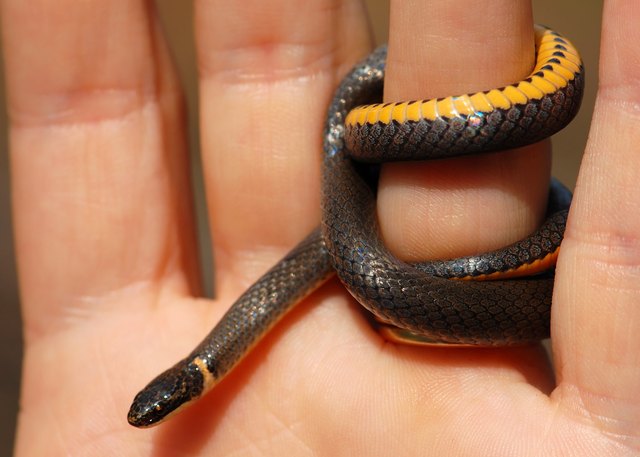How do baby snakes feed
How Do Snakes Feed Their Young And Do They Produce Milk?
Have you ever wondered how snakes feed their babies?
What kind of parenting skills do snakes have, anyway?
Every animal reproduces.
Creating and raising the next generation is a vital part of life.
Every animal must take care of its young in its own way.
A dolphin will nurse her calf; a human mother will nurse her baby.
But how do snakes nurse their young?
Snakes do not nurse their young. Instead, newborn snakes receive nutrients from their egg or sac yolk and quickly become self-sufficient once born.
Table of Contents
Why Don’t Snakes Nurse Their Young?
When a mother nurses her baby, she uses milk she internally produces.
This process is called lactation.
However, snakes, like all reptiles, do not lactate.
They do not possess mammary glands, which are essential for producing milk.
Lactating is an ability belonging only to mammals.
Other classes of animals, like fish, also do not nurse their young.
Non-lactating animals have different ways of feeding and caring for their babies.
How Do Snakes Feed Their Young?
If snakes don’t nurse their babies, how do they feed them?
The answer may surprise you – they don’t!
Snakelets are born fully mature and developed.
After a brief waiting period, they will be ready to fend for themselves.
Until they’re ready to hunt, the babies live off the nutrients existing in their bodies before they were born.
Baby snakes typically experience their first shed a week after birth.
Then, they’re ready to venture out on their own into the world!
What Do Baby Snakes Eat?
Since snakelets are fully developed, they have the same diet as their adult counterparts.
The only difference is the size of the food they can swallow.
Each snake has a different diet, but every snake is carnivorous.
Babies will find smaller prey like newborn mice, bugs, or tiny frogs.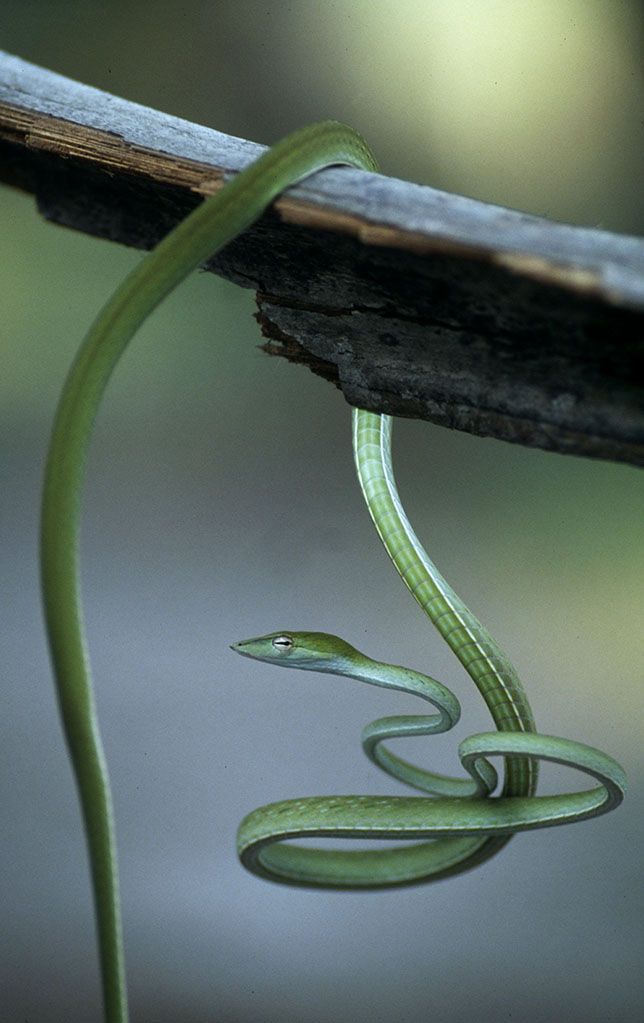
Snakes Are Born in Different Ways
There are a lot of differences in how snakes are born and how they care for their babies.
It entirely depends on the variety of the snake.
Around 70 percent of snakes are egg-producing.
Scientists use the term oviparous to refer to egg-laying snakes.
The remaining 30 percent give birth to live young.
The term for this is viviparous.
Some snakes do a combination of both – mothers will hold eggs inside them until they’re ready to hatch.
The babies will hatch inside the mother and will be live-birthed.
This is known as ovoviviparity (“partial live birth”).
Some snakes don’t parent their babies at all.
Others tend to their eggs until they hatch, then they leave the snakelets to fend for themselves.
And still, others watch over their young until it’s time for them to leave the burrow.
Oviparous Snakes (Born From Eggs)
Babies get their first nutrition from the yolk inside their eggs.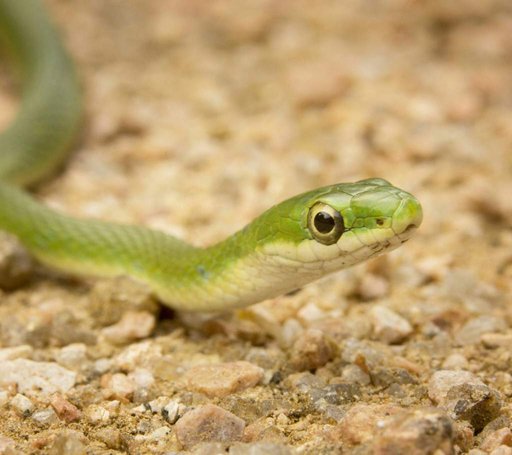
As a snake embryo develops, it will consume the yolk.
It will also receive some outside moisture and oxygen permeating through the eggshell.
Egg-laying snakes usually don’t care for their babies at all!
Mothers will deposit their clutch of eggs in a safe place, then leave them there.
An ideal place to deposit eggs is warm, dark, and damp from surrounding vegetation.
The babies will hatch and need to fend for themselves instantly.
There are exceptions to this rule.
Cobras and python mothers will watch over their eggs and their hatchlings until the babies are ready to leave the burrow.
This process of parenting is exhausting for an African python mother.
From the time she is initially pregnant to when her babies leave home, she won’t hunt or eat anything.
She could lose up to 40 percent of her body weight!
She even turns black (African pythons are typically brown) to absorb more heat to warm her eggs.
The African python mother will coil around her eggs.
Once the babies hatch, they will aggregate with their mother, meaning they will all cuddle together to keep warm.
Viviparous Snakes (Live-Birthed)
Viviparity (giving live birth) is the rarest form of reproduction in snakes.
Only a few snake varieties, like boas and water snakes, give live birth.
This means babies develop in a placenta and a yolk sac similar to mammals.
Unborn snakes receive sustenance from the nutrients in their amniotic sac.
Once born, these nutrients will tide the snakelets over until their first shed, when they begin hunting.
Check out our list of 11 snakes that have live babies for some cool facts and pictures.
Ovoviviparous Snakes (Partially Live-Birthed)
Ovoviviparity (giving partial live birth) is much more common in snakes.
It is a combination of laying eggs and giving live birth.
Because the process is similar to viviparity, scientists sometimes debate whether it should be considered a separate category.
Rattlesnakes and garter snakes are a few examples of ovoviviparous snakes.
Mothers will retain their clutches of eggs inside their bodies, hosting the young snakes until they’re ready to be born.
Ovoviviparous babies develop in a soft and permeable eggshell.
They get nourished from the egg yolk, and nutrition and oxygen pass from mother to child through the thin egg membrane.
When the babies are ready to be born, they hatch inside the mother; then, they give birth to live young.
Why Some Snakes Give Live Birth
There are many good reasons why certain snakes evolved into live-birthing animals.
- Protecting unhatched eggs from predators: it’s dangerous to leave defenseless unborn babies unattended.
- Protecting the mother from predators: a mother is at risk when she is pregnant and weaker from not eating.
- Environmental influences: tree snakes rarely come down from their perches; water snakes rarely come to shore.
A lot of venomous snakes give live birth.
Scientists think it’s because the babies are much safer inside a venomous mother than being left defenseless inside their unhatched eggs.
Staying inside their mother until fully developed gives them a much better chance of survival.
How Rattlesnakes Care for Their Young
Rattlesnakes have a few unique qualities.
Some of their parenting techniques are different from many other live-birthing snakes.
Most viviparous snakes will leave their babies to fend for themselves right after birth.
But rattlesnakes keep their newborn snakelets close to home.
Rattlesnake babies are thought to have a predator-attracting odor.
Their mothers will guard the babies in their den.
Like African pythons, some rattlesnake mothers change to darker skin color to retain more heat and keep their babies warm.
They will aggregate in their den with their young.
If their babies start to stray too far from home, mothers will warn them with a tapping motion.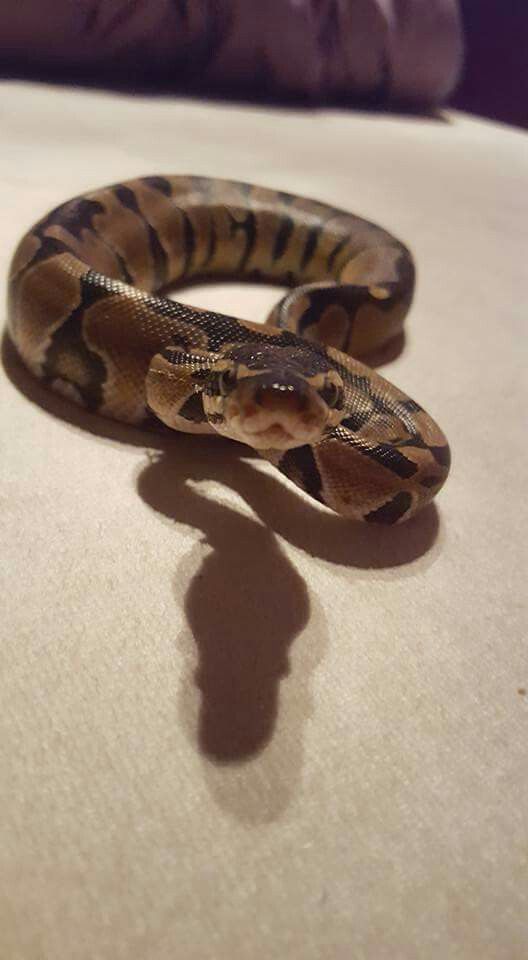
Once rattlesnake babies shed for the first time, they too are ready to leave the den and journey into the world.
Conclusion
Now we know how snakes nurse their young; they don’t!
They have different methods to give their babies nourishment.
Baby snakes rely on the yolks inside their eggs or placentas, which they eat as they develop into fully mature newborn snakes.
Baby snakes eat the same carnivorous diet as their parents, just in smaller portions.
Some snake mothers will deposit their eggs and leave them to hatch later.
Others will guard their eggs and keep them warm until they hatch but won’t care for their snakelets at all.
Others will guard their newborn babies until the snakelets can hunt.
Regardless of individual parenting styles, baby snakes are born into this world fully mature and ready to get their lives started!
What Do Newborn Baby Snakes Eat?
How do you take care of baby snakes?
Do they eat the same as adults?
Breeding snakes is a fun extension of owning these slithery pets, but you need to know how to take care of them.
Diet is the most critical step at this age, which is why you need to ask yourself:
What do newborn snakes eat?
Newborn snakes in the wild will forage for small animals, insects, and eggs. If feeding pet baby snakes, stick with pinky mice or smaller newborn mice or chicks. Baby snakes may not want to eat for a few days, but they should be eating within a month of their birth.
Table of Contents
What Do Baby Snakes Eat In The Wild?
When baby snakes are born in the wild, their mothers leave them to forage for themselves.
Some mother snakes will leave their hatchlings to emerge from their eggs and find food on their own.
Some mothers will stay for a little while caring for their young, leaving after their babies’ first skin shed.
Read our post on how long baby snakes stay with their mother for more information.
Mother snakes do not generally provide food for their young after they have left their bodies, either through egg-laying or live birth.
Once they are out in the world, baby snakes will forage and hunt insects, frogs, mice, other reptiles, and eggs.
The animals’ young adult snakes of the same species tend to eat are good choices for baby snakes.
Being small, hatchling and neonate snakes need smaller prey to digest their food correctly.
As they grow, the size of their food will grow with them.
What Do I Feed My Pet Baby Snakes?
The first fact you should know about feeding your newborn snakes is they do not need to eat right away.
They will probably not be interested in food until a few days after birth.
They generally have enough nutrition in their systems to sustain them.
However, they should be eating within the first month of their births.
Around their first skin shed, which should be a week to two weeks after birth, is an excellent time to offer them food if they have not been interested up until this point.
Some baby snakes will take longer to eat than others.
The important thing is to be persistent and patient.
A good rule of thumb for feeding any snake of any age is not to provide a snake an animal wider than the widest point of their body.
If you feed a snake a prey animal too large, you may cause digestive issues or regurgitation of food.
For newborn snakes, you will generally want to stick with pinky mice or newborn mice who have not grown fur yet.
If a single pinky mouse is too big for your newborns, cut it in half.
You may also be able to find smaller newborn mice for feeding, like pygmy mice or spiny mice.
Frozen Mice Combo Pack of 50 Small & Large Pinkies
- Humane
- Frozen
- Fresh
Check Price on Amazon
Deals on Chewy
We earn a commission if you click this link and make a purchase at no additional cost to you.
What If My Baby Snake Is Not Eating?If it has been a month and your newborn is still not eating, there could be a few reasons.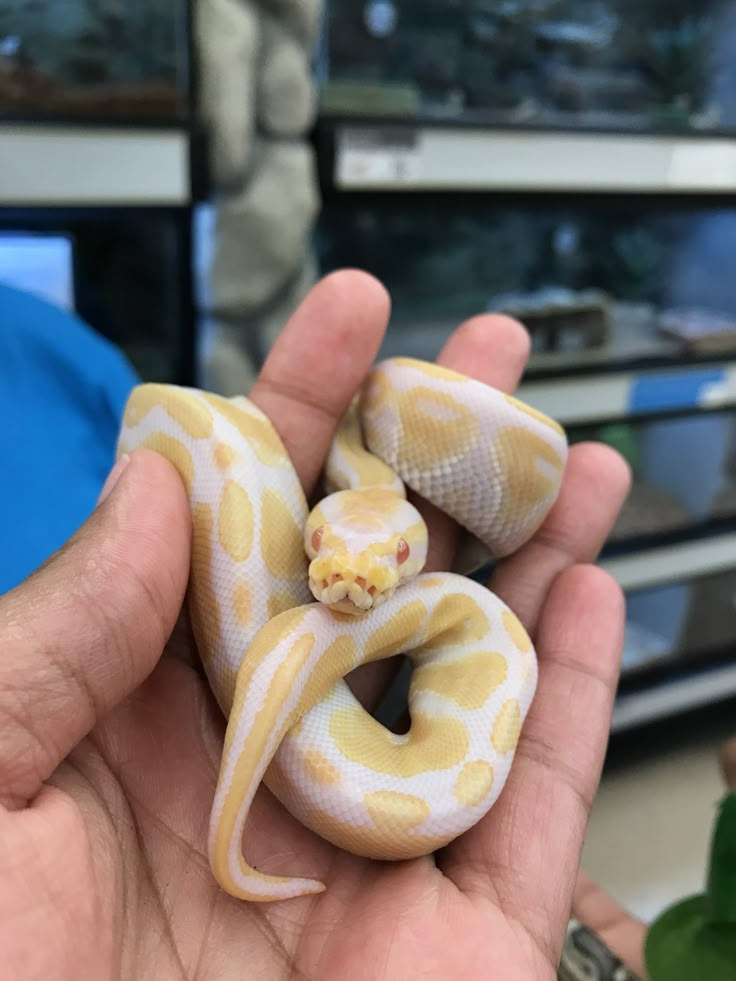
The scent of its prey could turn off the snake.
Wash the prey gently with water and an unscented soap before feeding.
The smell of a different, more enticing prey may also help.
Rub the pinky mouse with a feeder chick or a different reptile or amphibian.
Feeder chicks are also available for food if your snake appears to not like mice.
Make sure a feeder chick is no wider than the widest point of the baby snake.
The smell of brain matter will also entice a picky snake.
Split the skull open of whatever you are feeding your snake.
Your baby snake may not feel comfortable enough in its environment to eat.
Using a thermometer and hygrometer, make sure your snake’s enclosure is at the proper temperature and humidity for its species.
If you have all your neonates in the same environment, split them into different ones.
Make sure your hatchling has a hide where it is currently living.
This will help it feel safe while eating.
We do not recommend force-feeding your snake, as this will cause stress.
With a baby snake, it may associate trauma with eating.
It should only be used as a very last result.
If you need to force feed, make sure not to force the next feeding.
What About Water?Snakes usually absorb water by soaking in it, not drinking it.
Provide an adequate-sized soaking bowl for your snake.
It should have about an inch of warm water in it.
Spraying with a spray mister will also provide moisture.
Keeping your snake’s enclosure at the proper humidity should also help with providing enough moisture and hydration.
Monitor your baby snakes for signs of constipation or dehydration.
These include not defecating within ten days of a meal and not eating, especially if they were eating before.
If your snake is dehydrated, it will not shed its skin in a single piece.
Contact your veterinarian if you observe these symptoms in your snakes.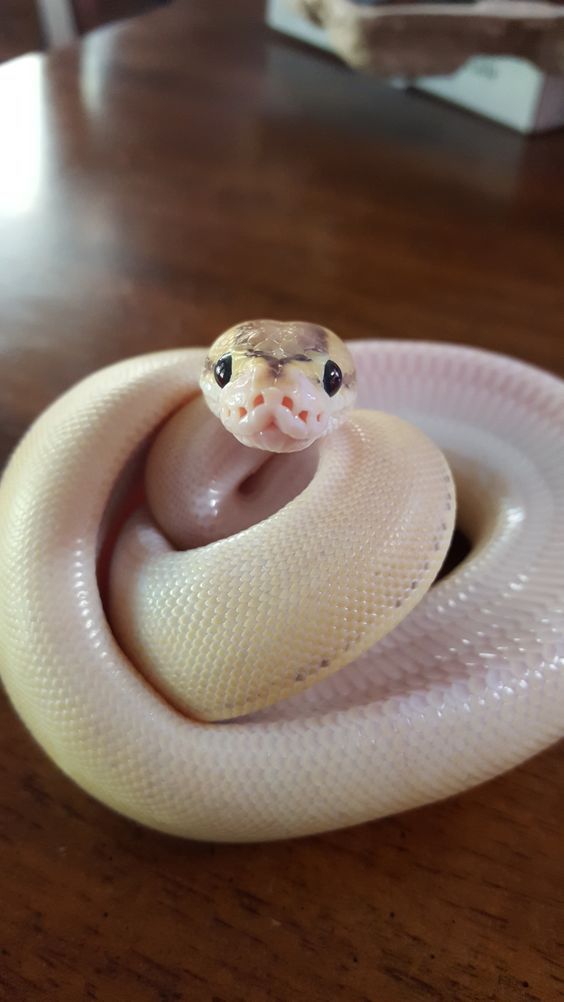
Digestive impaction is a severe problem for snakes and could be fatal if left untreated.
Conclusion
We hope this article has helped you feed your newborn snakes.
In the wild, baby snakes must take care of themselves.
Even if mother snakes stick around for a while, they will usually not feed their young.
Newborn snakes forage for smaller prey than their parents would eat.
The size of their food will grow as they grow.
If you care for newborn snakes, stick with the smallest available feeder prey.
This usually means pinky mice.
Keep in mind your baby snakes may not want to eat right after being born.
We have provided a few ways to entice your snake into eating if it has not eaten within the first month of its life.
Be sure to provide sources of fresh water for your snake, too.
What do snakes eat in nature. What do snakes eat. Who eats bird snakes
What do snakes eat?
All snakes are carnivores and therefore never eat plant foods. Since snakes swallow their prey whole, they have very caustic digestive juices.
Since snakes swallow their prey whole, they have very caustic digestive juices.
The jaws of a snake have an unusual structure. They are very weakly connected to other bones of the skull. Tiny teeth grow along the edge of the jaws, and some snakes also grow two additional rows of teeth in the palate. All these teeth are connected to bones, which are set in motion by special muscles.
| |
Rattlesnake example.
Having captured the prey, the snake holds it with the teeth of the lower jaw, and pushes it into the mouth with the upper one. When the food has already passed halfway into the mouth, the lower jaw also begins to help the upper jaw move the food deeper into the esophagus.
Due to the special structure of the jaw, the snake can swallow large animals. So, for example, pythons sometimes swallow leopards and deer! But, of course, small individuals eat small animals. Most snakes still feed on medium-sized living creatures: grasshoppers, frogs, fish, mice, rats and birds. Some tiny blind snakes only eat termites. And there are also snakes that prey on their own kind.
Most snakes still feed on medium-sized living creatures: grasshoppers, frogs, fish, mice, rats and birds. Some tiny blind snakes only eat termites. And there are also snakes that prey on their own kind.
As for food, these reptiles are very fastidious. So, the green snake eats spiders, fish, birds, caterpillars, but will not touch lizards and mice, and the water snake is not indifferent to fish and frogs, but will ignore insects and mice.
Anacondas eat a variety of foods.
Snake is an animal of the chordate type, reptile class, squamous order, suborder snakes (Serpentes). Like all reptiles, they are cold-blooded animals, so their existence depends on the ambient temperature.
Snake - description, characteristics, structure. What does a snake look like?
The body of the snake has an elongated shape and can reach a length of 10 centimeters to 9 meters, and the weight of the snake ranges from 10 grams to more than 100 kilograms. Males are smaller than females but have longer tails. The body shape of these reptiles is varied: it can be short and thick, long and thin, and sea snakes have a flattened body that resembles a ribbon. Therefore, the internal organs of these scaly also have an elongated structure.
Males are smaller than females but have longer tails. The body shape of these reptiles is varied: it can be short and thick, long and thin, and sea snakes have a flattened body that resembles a ribbon. Therefore, the internal organs of these scaly also have an elongated structure.
The internal organs are supported by more than 300 pairs of ribs movably connected to the skeleton.
The triangular head of the snake has jaws with elastic ligaments, which makes it possible to swallow large food.
Many snakes are venomous and use venom as a means of hunting and self-defense. Since snakes are deaf, for orientation in space, in addition to vision, they use the ability to capture vibration waves and thermal radiation.
The main information sensor is the snake's forked tongue, which allows using special receptors inside the sky to "collect information" about the environment. Snake eyelids are fused transparent films, scales that cover the eyes, so snakes do not blink and even sleep with their eyes open.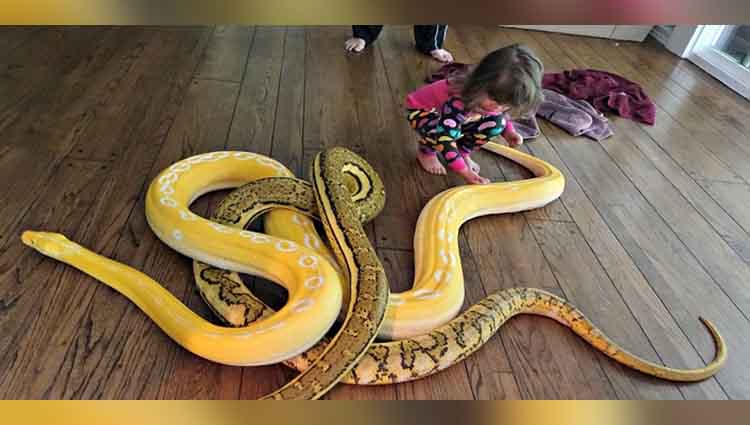
The skin of snakes is covered with scales, the number and shape of which depends on the type of reptile. Once every six months, the snake sheds old skin - this process is called molting.
By the way, the color of the snake can be both monochromatic in species living in the temperate zone, and variegated in representatives of the tropics. The pattern may be longitudinal, transversely annular or spotted. Snake species, names and photos having both lungs as well as rudimentary remnants of the pelvic bones and hind limbs.
Consider several representatives of the snake suborder:
- King cobra (hamadryad) ( Ophiophagus hannah )
The largest venomous snake on earth. Individual representatives grow up to 5.5 m, although the average size of adults usually does not exceed 3-4 m. King cobra venom is a deadly neurotoxin that is fatal in 15 minutes. The scientific name of the king cobra literally means “snake eater”, because it is the only species that feeds on snakes of its own kind.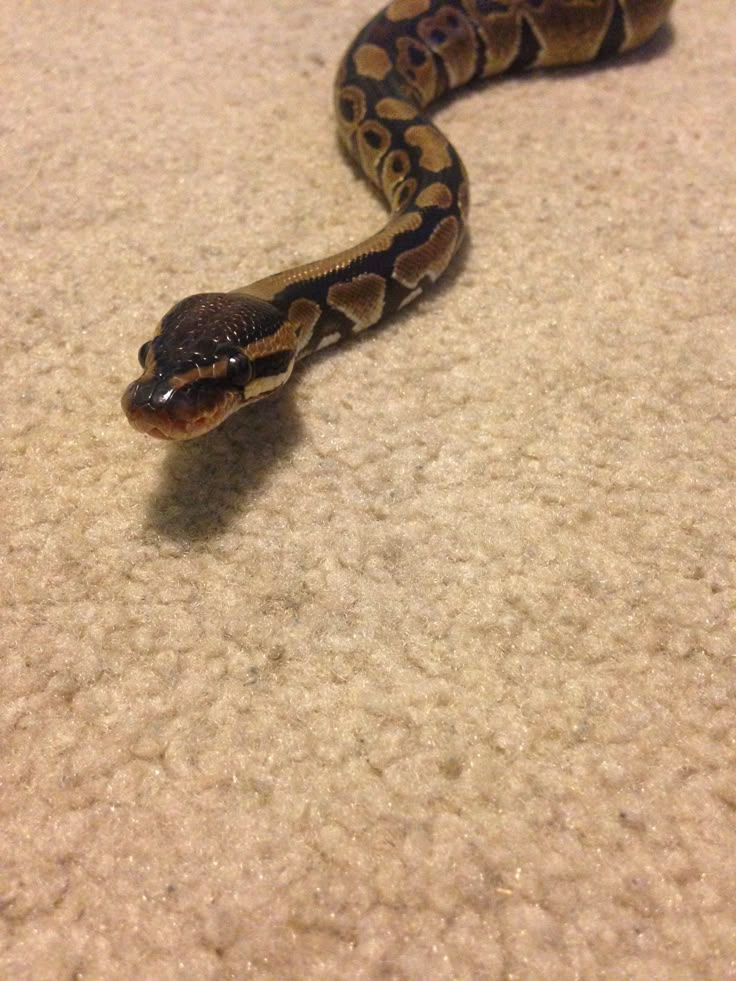 Females have an exceptional maternal instinct, constantly guarding the laying of eggs and completely do without food for up to 3 months. The king cobra lives in the tropical forests of India, the Philippines and the islands of Indonesia. Life expectancy is over 30 years.
Females have an exceptional maternal instinct, constantly guarding the laying of eggs and completely do without food for up to 3 months. The king cobra lives in the tropical forests of India, the Philippines and the islands of Indonesia. Life expectancy is over 30 years.
- Black mamba ( Dendroaspis polylepis )
The African venomous snake, growing up to 3 m, is one of the fastest snakes, capable of moving at a speed of 11 km/h. The highly toxic snake venom results in death within minutes, although the black mamba is not aggressive and only attacks humans in self-defense. Representatives of the species black mamba got their name due to the black color of the oral cavity. Snake skin is usually olive, green, or brown in color with a metallic sheen. It eats small rodents, birds and bats.
- Violent snake (desert taipan) ( Oxyuranus microlepidotus )
The most poisonous of land snakes, the venom of which is 180 times stronger than that of a cobra. This species of snake is common in the deserts and dry plains of Australia. Representatives of the species reach a length of 2.5 m. Skin color changes depending on the season: in extreme heat - straw, when it gets cold it becomes dark brown.
This species of snake is common in the deserts and dry plains of Australia. Representatives of the species reach a length of 2.5 m. Skin color changes depending on the season: in extreme heat - straw, when it gets cold it becomes dark brown.
- Gaboon viper (cassava) ( Bitis gabonica )
The venomous snake living in the African savannas is one of the largest and thickest vipers up to 2 m long and almost 0.5 m in circumference. All individuals belonging to this species have a characteristic, triangular head with small horns located between the nostrils. The Gaboon viper has a calm nature, rarely attacking people. Belongs to the type of viviparous snakes, breeds every 2-3 years, bringing from 24 to 60 offspring.
- Anaconda ( Eunectes murinus )
Giant (ordinary, green) belongs to the subfamily of boas, in the old days the snake was called that - a water boa. A massive body with a length of 5 to 11 m can weigh over 100 kg.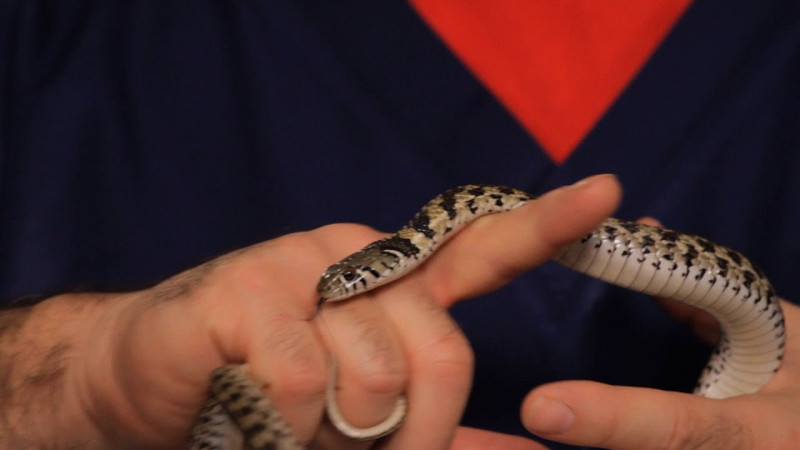 A non-poisonous reptile is found in low-flowing rivers, lakes and backwaters of the tropical part of South America, from Venezuela to the island of Trinidad. It feeds on iguanas, caimans, waterfowl and fish.
A non-poisonous reptile is found in low-flowing rivers, lakes and backwaters of the tropical part of South America, from Venezuela to the island of Trinidad. It feeds on iguanas, caimans, waterfowl and fish.
- Python ( Pythonidae )
A representative of the family of non-venomous snakes is characterized by gigantic sizes from 1 to 7.5 m in length, and females are much larger and more powerful than males. The range extends throughout the eastern hemisphere: tropical forests, swamps and savannahs of the African continent, Australia and Asia. The diet of pythons consists of small and medium-sized mammals. Adults swallow leopards, jackals and porcupines whole, and then digest them for a long time. Female pythons lay their eggs and incubate the clutch, increasing the temperature in the nest by 15-17 degrees by muscle contraction.
- African egg snakes (egg-eaters) ( Dasypeltis scabra )
Members of the snake family that feed exclusively on bird eggs. They live in the savannas and woodlands of the equatorial part of the African continent. Individuals of both sexes grow no more than 1 meter long. The movable bones of the snake's skull make it possible to open the mouth wide and swallow very large eggs. In this case, the elongated cervical vertebrae pass through the esophagus and, like a can opener, open the eggshell, after which the contents flow into the stomach, and the shell is expectorated.
They live in the savannas and woodlands of the equatorial part of the African continent. Individuals of both sexes grow no more than 1 meter long. The movable bones of the snake's skull make it possible to open the mouth wide and swallow very large eggs. In this case, the elongated cervical vertebrae pass through the esophagus and, like a can opener, open the eggshell, after which the contents flow into the stomach, and the shell is expectorated.
- Radiant snake ( Xenopeltis unicolor )
Non-poisonous snakes, rarely up to 1 m in length. The reptile got its name from the iridescent sheen of its dark brown scales. Burrowing snakes inhabit the loose soils of forests, cultivated fields, and gardens in Indonesia, Borneo, the Philippines, Laos, Thailand, Vietnam, and China. Small rodents and lizards are used as food objects.
- Vermicular blind snake ( Typhlops vermicularis )
Small snakes, up to 38 cm long, look like earthworms. Absolutely harmless representatives can be found under stones, melons and watermelons, as well as in bushes and on dry rocky slopes. They feed on beetles, caterpillars, and their larvae. The distribution zone extends from the Balkan Peninsula to the Caucasus, Central Asia and Afghanistan. Russian representatives of this species of snakes live in Dagestan.
Absolutely harmless representatives can be found under stones, melons and watermelons, as well as in bushes and on dry rocky slopes. They feed on beetles, caterpillars, and their larvae. The distribution zone extends from the Balkan Peninsula to the Caucasus, Central Asia and Afghanistan. Russian representatives of this species of snakes live in Dagestan.
Where do snakes live?
The snake distribution area does not include only Antarctica, New Zealand and the islands of Ireland. Many of them live in tropical latitudes. In nature, snakes live in forests, steppes, swamps, hot deserts and even in the ocean. Reptiles are active both during the day and at night. Species living in temperate latitudes hibernate in winter.
Snakes occupy a special place among the exotic animals that have recently become popular to keep at home. Both poisonous and non-dangerous reptiles live at home. Next, let's talk about what such pets eat and whether their diet differs from the natural one.
The reptiles in question eat small animals. These reptiles that feed on plants do not exist - absolutely all of them are predators.
Their menu is very diverse and depends on the size and type - it can be both small insects and larger mammals. Some species eat absolutely everything they catch, and some are quite selective. The diet directly depends on the habitat.
Do you know? The oldest snake in the world - Popeye the boa lived for almost forty-one years.
Wild
Reptile diet depends on preference, habitat and size. It is difficult to list the prey that they can consume, so let's focus on the most common types of it.
| Type of food | Note |
| Insects | Representatives of this class form the basis of the diet of many venomous and non-venomous small snakes. They also begin to feed on snake cubs. Some reptiles, such as blind snakes, can eat ants, termites |
| Mammals | A reptile, if it feeds on mammals, can catch and eat any animal smaller than itself. The food chain begins with a small mouse and ends with an antelope. Snakes don't eat anything too thick or spiky, like hedgehogs. The food chain begins with a small mouse and ends with an antelope. Snakes don't eat anything too thick or spiky, like hedgehogs. |
| Birds and their eggs | Those species of reptiles that, as a rule, have adapted to climb trees and hunt there, feast on birds. They also eat feathered eggs |
| Fish | Fish are also creatures that are eaten by reptiles. They feed on those species that live in or near water. |
| Amphibians | Many reptiles eat amphibians, which are abundant in their habitat. It can be frogs, salamanders, newts, worms |
| Shellfish | Fathead snake, found in Asia and America, prefers to feast on snails and slugs. With the help of the lower jaw and teeth in the form of a hook, she removes the mollusk from the shell and eats it. |
| Other snakes | It is very unusual that some species of reptiles eat their own kind. For some, relatives are a "supplement" to the diet, while others, such as the Brazilian Mussurana, eat only them. For some, relatives are a "supplement" to the diet, while others, such as the Brazilian Mussurana, eat only them. |
class="table-bordered">
There have been cases when people were found in the stomachs of large snakes, such as pythons and boas. There are even photographs of these events. However, it cannot be said that these reptiles consider humans as potential prey: this is an exception to the rule.
What to feed at home
Feed reptiles at home the same as they eat in the wild. As a rule, snakes are kept at home, which eat rodents, small birds, their eggs, amphibians and insects. There are few cases when large reptiles are kept, which, accordingly, feed on large mammals.
Reptiles are advised to give food either already inanimate or stunned: it can be fresh or frozen. The terrarium must have water.
Important! This reptile do not give milk: their body is not able to digest it, and disorder is possible.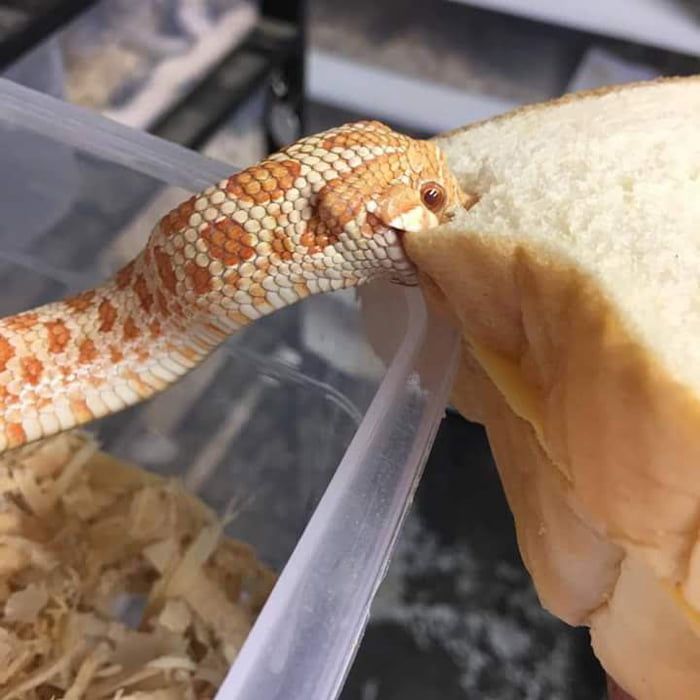
The reptile does not chew its prey, but swallows it whole. The poisonous reptile before this injects poison, which, in addition to the function of killing, also helps the gastric juices to digest the victim. Some species also suffocate it, and some eat it without killing it at all.
The snake swallowing process is very interesting, since in many cases the food is larger than the hunter in size. The upper and lower jaws are very mobile, as they are freely attached to the bones of the skull. In addition, the latter consists of two halves and stretches. With the lower jaw, the reptile holds the prey tightly, and pushes it through the upper jaw.
Important! When feeding venomous reptiles at home, be sure to follow safety precautions and have antivenom on hand just in case.
When food enters the esophagus through the throat, its muscles begin to work, which further push it into the stomach. It, in turn, contains very caustic juices that contribute to its digestion. This process may take several days. There are times when the snake still cannot push through the food, then it simply regurgitates it.
This process may take several days. There are times when the snake still cannot push through the food, then it simply regurgitates it.
Why snakes eat themselves
Herpetologists name several reasons why snakes eat their own kind. Some species do this because they eat anything, and smaller relatives just got in the way during the meal. Others eat snakes because it is the basis of their diet - it was so laid down by nature.
There is a hypothesis that the reptile in question is convenient to swallow due to the structure of its body. It is also possible that the smell of prey, which remained on relatives, provokes snakes to cannibalism.
There are species of snakes that eat the young and the remains of their eggs. This is done to recuperate when the reptile is weak after breeding.
Do you know? Snakes have eyelids in front of their eyes, and they are always closed. But this does not prevent the reptile from seeing, since they are transparent.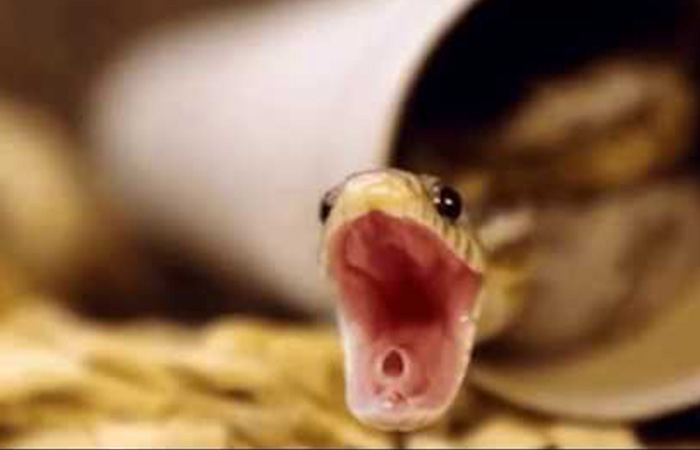
The feeding of snakes is as interesting as their behavior. Their diet is varied and sometimes very unusual. If you keep these reptiles at home, then they need to be fed food that is as close as possible to what they eat in the wild.
What do snakes eat?
All snakes are carnivores, none of them eating plant foods. The menu of snakes is very diverse, they eat almost everything that can be found in wildlife, and in this they far superior to amphibians. Snakes prey on a variety of mammals (ranging in size from a tiny shrew to an antelope), birds, other reptiles, amphibians and insects. They love to eat eggs from the clutches of birds and their own fellow reptiles. Species leading the water and semi-aquatic way of life, are engaged in fishing, and also catch other aquatic animals.
Shellfish
Also known are snakes that feed on shellfish. it fat-headed snakes living in America and Asia. They eat almost just slugs and snails. The last they extract from the shells masterfully: they insert the lower jaw into the shell and hook it with long curved teeth "leg" of the snail, and then, alternately working movably connected halves of the lower jaw, move the body of the mollusk straight into your mouth.
The last they extract from the shells masterfully: they insert the lower jaw into the shell and hook it with long curved teeth "leg" of the snail, and then, alternately working movably connected halves of the lower jaw, move the body of the mollusk straight into your mouth.
Ants
Many blind snakes feed on ants - small snakes living in the soil. They catch earth ants that come across in passages and cracks in the soil. One common blind snake can eat 200 ants per day, with a preference for certain types of ants or their larvae. It emits a specific odor, due to which ants do not touch her even in an anthill.
Termites
Few species of reptiles feed on termites. For example, one of the blind snakes is able to squeeze out the contents of a soft the abdomen of a termite, leaving its chitinous shell.
Snakes
Many reptiles prey on other members of their class. But the most dramatic and striking example is the predation of snakes in relation to other snakes. Many snakes that are not very picky about food can, on occasion, swallow one of the smaller representatives of the snake kingdom. Even the well-known ordinary one, on occasion, can dine viper. However, there are more specialized species that feed only on lizards and snakes. This is a relatively rare copperhead in the center of Russia. This small snake preys mainly on lizards, but when it encounters a snake or a viper of a suitable size will try to swallow them too. Finally, there is a very special group of snakes that feed mainly on other snakes. Among them is the world's largest venomous snake - king cobra, or Hamadryad. This Asian snake reaches five meters in length and specifically hunts for other snakes, including extremely poisonous ones. It's interesting that cobras and other aspid snakes kill the snakes that have become their prey with their poison. At the same time, their poison effectively acts, for example, on vipers, while while the poison of vipers is powerless against them.
Many snakes that are not very picky about food can, on occasion, swallow one of the smaller representatives of the snake kingdom. Even the well-known ordinary one, on occasion, can dine viper. However, there are more specialized species that feed only on lizards and snakes. This is a relatively rare copperhead in the center of Russia. This small snake preys mainly on lizards, but when it encounters a snake or a viper of a suitable size will try to swallow them too. Finally, there is a very special group of snakes that feed mainly on other snakes. Among them is the world's largest venomous snake - king cobra, or Hamadryad. This Asian snake reaches five meters in length and specifically hunts for other snakes, including extremely poisonous ones. It's interesting that cobras and other aspid snakes kill the snakes that have become their prey with their poison. At the same time, their poison effectively acts, for example, on vipers, while while the poison of vipers is powerless against them. Among the serpent-eaters there are considered non-poisonous or possessing a weak poison (including applies, for example, copperhead). The brightest representative of this group is mussurana, common in Central America. This rather large snake (sometimes exceeding 2 m) hunts, mainly on large and strong deadly to humans pit snakes. Mussuran grabs his prey in a sharp throw behind the neck behind the head and with lightning speed wraps her body around her. Thereafter, without opening the jaws, but gradually sorting through them, captures in the mouth head of the victim and gradually begins to swallow it. Mussurana herself too poisonous, and its poison, although it does not kill prey, but noticeably weakens it. At In this case, the poison of the victims has practically no effect on the predator. snake hunting for other snakes, gets one indisputable advantage: to swallow a long, narrow and smooth creature, of course, much lighter than some kind of spherical egg or angular toad.
Among the serpent-eaters there are considered non-poisonous or possessing a weak poison (including applies, for example, copperhead). The brightest representative of this group is mussurana, common in Central America. This rather large snake (sometimes exceeding 2 m) hunts, mainly on large and strong deadly to humans pit snakes. Mussuran grabs his prey in a sharp throw behind the neck behind the head and with lightning speed wraps her body around her. Thereafter, without opening the jaws, but gradually sorting through them, captures in the mouth head of the victim and gradually begins to swallow it. Mussurana herself too poisonous, and its poison, although it does not kill prey, but noticeably weakens it. At In this case, the poison of the victims has practically no effect on the predator. snake hunting for other snakes, gets one indisputable advantage: to swallow a long, narrow and smooth creature, of course, much lighter than some kind of spherical egg or angular toad.
Enemies of snakes significantly reduce their population. What animals eat snakes You will learn in this article.
What animals eat snakes You will learn in this article.
Which animal eats snakes?
Snakes appear to be strong poisonous animals that instill fear in others. But there are daredevils who eat them. These are:
- birds of prey
- mongooses,
- crocodiles,
- wild pigs and wild boars,
- representatives of the cat family,
- monitor lizards
- other animals (depending on the specific habitat).
It is well known that hedgehogs are resistant to snake venom. Having met with a viper, the hedgehog sniffs it from head to tail, despite the fact that the snake bites him. He simply licks the wounds with his tongue. Then he clings to the viper and begins to eat it. The body of the hedgehog is not exposed to the snake's venom, so its bites do not cause him any harm. Other animals that eat snakes are martens, weasels, foxes, and ferrets. In countries with a warm climate, the enemies of hissing creatures are mongooses. They even cope with a spectacled snake.
They even cope with a spectacled snake.
Who eats bird snakes?
Birds of prey eat snakes - falcon, hawk, stork, peacock, etc.
Many birds prey on snakes, including poisonous ones. These include the snake eagle, hawk, vulture, buzzard, stork and even a crow. The most dangerous enemy among birds for snakes is the secretary bird living in Africa. It eats the creeping creature completely, along with its venom glands and teeth.
AMAZING MILFS | Science and life
Organisms living on earth have a problem reproduction of offspring is one of the most important. Everything must be fruitful and multiply, not to disappear forever from the face of the Earth. Solution to this problem in animals occurs by the union of gametes, or sex cells. There is no other way. Not only begins, but any living organism develops in principle in the same way. But the external conditions for the development of the embryo may be different. And our sophisticated the imagination will once again be amazed at how wise, "not by chance" and at the same time, to the point of paradoxical bizarre, absurd, from the point of view of abstract schemes and theories, everything is arranged in nature.
And our sophisticated the imagination will once again be amazed at how wise, "not by chance" and at the same time, to the point of paradoxical bizarre, absurd, from the point of view of abstract schemes and theories, everything is arranged in nature.
Marsupial tree frog with eggs in pouch on back.
Surinam pipa with a network of brood cells on the back. Tadpoles hatch from the cells.
Male Rhinoderma frog with tadpoles in throat pouch.
‹
›
View full size
Back Incubator
We all know well that mammals give birth to live young, birds lay eggs. So do many reptiles, including crocodiles and turtles. The extinct ones were also oviparous dinosaurs from the face of the Earth (see "Science and Life" No. 5, 1997). But about that that some lizards and snakes, as well as amphibians, give birth to live young, not everyone knows.
Most viviparous reptiles, strictly in other words, not truly viviparous. Animals and humans form a special The "place of connection" of the new organism with the mother is the placenta. Through this body cub receives all the nutrients and oxygen with the mother's blood, and removes decay products. In viviparous reptiles, everything is somewhat different. Embryo develops inside their eggs, which simply linger in the oviducts females for the entire period of "pregnancy". The embryo receives from the mother only water, and draws nutrients from the yolk of the egg. live birth without the formation of a placenta, biologists call ovoviviparity. Similar way "chosen" by many lizards and snakes. Some of them, such as dovetail sea serpents, and you don’t have to choose - they spend their whole lives in the water element, and in reptile eggs cannot develop in water.
Animals and humans form a special The "place of connection" of the new organism with the mother is the placenta. Through this body cub receives all the nutrients and oxygen with the mother's blood, and removes decay products. In viviparous reptiles, everything is somewhat different. Embryo develops inside their eggs, which simply linger in the oviducts females for the entire period of "pregnancy". The embryo receives from the mother only water, and draws nutrients from the yolk of the egg. live birth without the formation of a placenta, biologists call ovoviviparity. Similar way "chosen" by many lizards and snakes. Some of them, such as dovetail sea serpents, and you don’t have to choose - they spend their whole lives in the water element, and in reptile eggs cannot develop in water.
Sharp border between ovoviviparity and oviposition does not exist. Sometimes the eggs are only delayed for a while in the oviduct, and the females lay them with a partially formed embryo, which then develops outside the mother. This is what happens to those living in the South America prickly, or, as they are also called, fences, iguanas. Some types living on the plain, lay eggs, and high-mountain species close to them "give birth" live babies.
This is what happens to those living in the South America prickly, or, as they are also called, fences, iguanas. Some types living on the plain, lay eggs, and high-mountain species close to them "give birth" live babies.
Occurs only in a few species of reptiles so-called true live birth. The amount of yolk in an egg is noticeable decreases, and the embryo largely feeds on the mother's body. It even forms a kind of placenta: the skin of the egg dissolves, and between the blood vessels of the wall of the oviduct of the mother and the baby is established close mutual relationship. Thus produce offspring living in our forests in central Russia, viviparous lizard and common viper. Actually, thanks to such a perfect way of bearing cubs these two species survived in the cold northern latitudes, where reptiles in general is having a hard time. Many types of skinks differ in the same feature. - lizards with an elongated body and short legs (some look like snakes), gone "under the ground" - into the soil and settled in many mountain ranges.
Oviparous birth occurs not only reptiles, but also fish and amphibians. Aquarists are well aware viviparous species of American cyprinids - mosquito fish, mollies, swordtails and guppies. This property is also characteristic of salamanders and viviparous toads.
Surinamese pipa and marsupial tree frogs have eggs develop directly on the body of the parents, in special brood "bags" (cells) on the back. During mating, the pip male presses on a kind of "ovipositor" females, and eggs, leaving it one by one, are evenly distributed on back of the female in cells. Each cell, after an egg was in it, acquires a hexagonal shape and is covered with a leather cap. Partitions between the cells are very thin and dotted with blood vessels through which eggs get water and probably some of the nutrients from the body mother. The formed young pipa breaks the cell and leaves the "nursery", placed on their mother's back. But even more incredible ways of development eggs from Chilean rhinoderm frogs and Australian rheobathracus frogs.
"Pregnant" dads
Male rhinoderm, small and brightly colored mountain frog, captures the eggs laid by the female in the water with her mouth and sends them - where would you think? - in the throat bag. There will now develop cubs. First, the embryos receive nutrients from the yolk, and then grow back to the wall of the throat sac rich in blood vessels your parent. When the formation of the embryos ends, the youth is torn apart these "bridges" and safely gets out of the throat bag first into the mouth father's cavity, and then out. The funny thing is that all this time the male continues to eat.
Australian rheobathracuses are no less original. In these frogs, the female swallows the laid eggs, and the eggs (and then tadpoles) develop directly in the mother's stomach, feeding on the secretions of its mucous membrane. Grown up frogs gradually move to the mouth cavity of the parent and finally come out of captivity to freedom. In that case, the female can no longer eat (otherwise she would have digested her cubs), and for a certain period of time, the work of the digestive glands.
And about caring dads, but now from the class of birds. Imagine the Antarctic winter: May-July in our calendar. Forty-degree frost, hurricane-force winds, dark polar night. And in the midst of winter, male emperor penguins, huddled together, among ice plains are hatching eggs! Unbelievable, but it is a fact. Indeed, nests they are not. In such a cold on any soil, the egg would instantly die. Each the male holds a single egg on its paws, it is sunk into a special leathery crease on the ventral side of the body. Warmth surrounds the egg on all sides, but what an unfortunate bird! By the time the chick hatches (first he, too, will sit on his father's paws and bask in his warm leathery fold) and a well-fed, fat mother will return from the sea, the male loses up to 40% of your weight. And he still has to go many tens of kilometers to open water. Now the female will starve for two months. Truly selfless birds but why such incredible sacrifices? If the female could keep her the only egg in the oviduct, as lizards and snakes do, it was not would be no problem. Swim, eat, fatten up, and hatched the chick would not have to travel tens of kilometers to the rescue water. What prevents birds from going to live birth?
Swim, eat, fatten up, and hatched the chick would not have to travel tens of kilometers to the rescue water. What prevents birds from going to live birth?
And what is the use of live birth for amphibians and reptiles?
There is no answer in textbooks
The benefits of live birth are undoubted and in various cases are different. The development of the cub inside the mother's body is reliable protects it from predators and bacteria, and also supplies the egg with water. This and more reliable nutrition of the embryo, and favorable, without fluctuations, microclimate, and as a result - the accelerated development of the cub. But also in laying eggs has its advantages. First, they can be postponed a lot, even though up to two hundred (in amphibians and reptiles). Secondly, the female is less exhausted and retains great viability. So the options "for" and "against" can be many, and in each case nature makes a separate choice. The largest number of viviparous reptiles is found in areas with cold climate.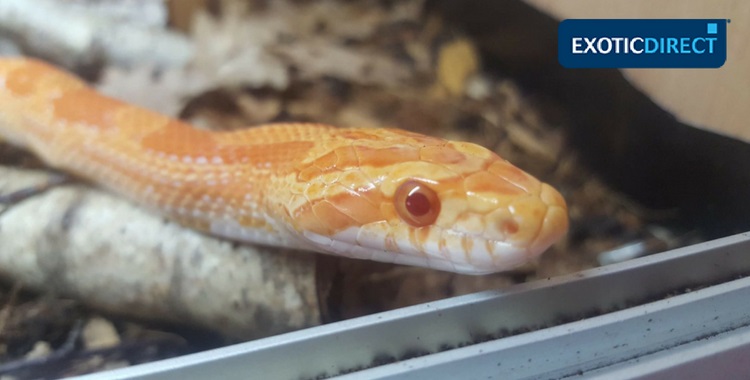
Why do lizards and snakes benefit from from live birth, and turtles, crocodiles and birds do not have a single case of transition to live birth, at least in the form of the rarest exception? It's really strange. After all, crocodiles and many turtles are aquatic animals for which communication with land during the breeding season is very painful, and sometimes dangerous for life. How many hundreds, and often thousands of kilometers, sea turtles to get to those oceanic islands or sandy patches coastline where they breed. And what awaits them there? The death of thousands of eggs and hatched turtles. Saves only a large number of eggs laid (up to fifty and even more), the frequency of clutches is up to seven per year.
Why don't aquatic turtles bear their offspring, as did, for example, the ancient ichthyosaurs? That fish lizards were viviparous, we know for sure, because in the skeleton of an adult ichthyosaur, just "under the very heart", they found the skeleton of a small, still unborn cub.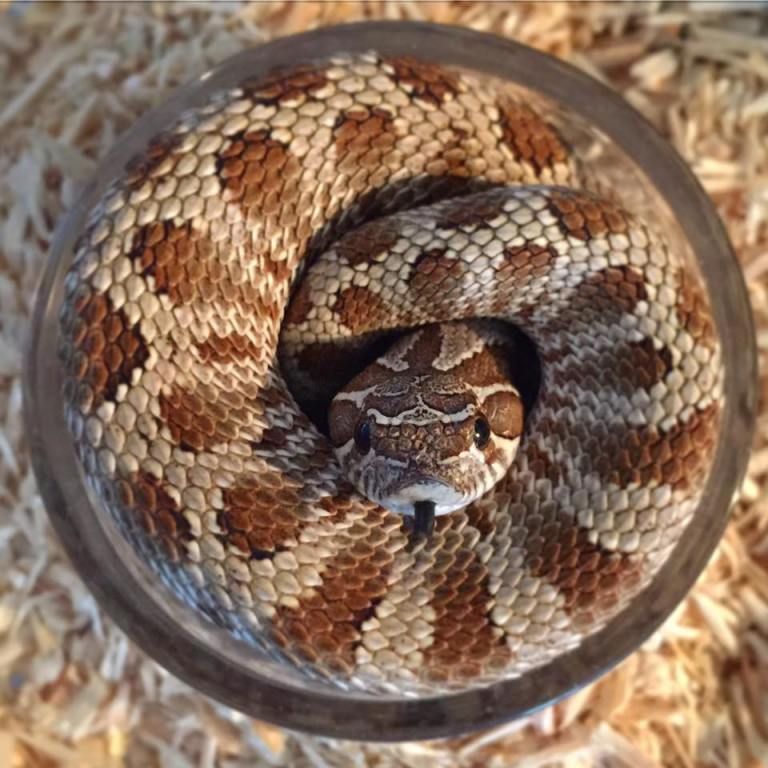 Yes, and it could not be otherwise, because the fish lizards did not come out at all land and, therefore, were "doomed" to live birth. Two out of three groups of water snakes are also viviparous. In the third group - sea snakes overwhelmingly most species give birth to live young. Without a doubt, it's "comfortable" and safe for aquatic reptiles. So why do turtles suffer so much?
Yes, and it could not be otherwise, because the fish lizards did not come out at all land and, therefore, were "doomed" to live birth. Two out of three groups of water snakes are also viviparous. In the third group - sea snakes overwhelmingly most species give birth to live young. Without a doubt, it's "comfortable" and safe for aquatic reptiles. So why do turtles suffer so much?
And the birds? To whom, if not warm-blooded animals be viviparous! How many eggs die from hypothermia, from flooding nests and, most importantly, is ruined by predators. How many problems does an embryo immured into the limestone fortress of the shell! (See "Science and Life" No. 10, 1998). Yes and for the bird itself, incubation of eggs is often the most vulnerable period in life: predators often catch the hen right on the eggs. Live birth would solve many problems, and this is perfectly demonstrated by animals, or mammals.
But birds fly... So what? Before In total, many species of birds lay only one egg. That's what marines do birds - albatrosses, petrels, phaetons and frigates, some large predator birds. Even more birds lay two eggs each - also a small burden. After all, with one egg, until it is laid, the bird flies! Many ducks in during the incubation of eggs, they molt and at once lose all flight feathers. Fly them not necessary at this time. Finally, penguins do not fly at all, but about how much torment they have to endure because of the need to incubate an egg, we have already spoken.
That's what marines do birds - albatrosses, petrels, phaetons and frigates, some large predator birds. Even more birds lay two eggs each - also a small burden. After all, with one egg, until it is laid, the bird flies! Many ducks in during the incubation of eggs, they molt and at once lose all flight feathers. Fly them not necessary at this time. Finally, penguins do not fly at all, but about how much torment they have to endure because of the need to incubate an egg, we have already spoken.
In textbooks answers to all these questions we won't find. It remains to think, reflect. One thing is clear: there is some kind of fundamental ban that does not allow turtles, crocodiles and birds go to live birth. What unites these animals? Some are flying others almost never come out of the water, others - like land turtles - exclusively crawl on dry land. Everyone is so different and... everyone lays eggs with hard shells, which lizards and snakes do not. Isn't there a clue here? Has the shell become an insurmountable obstacle to such a simple transition to ovoviviparity? There is a blessing in disguise - after all, the shell allows birds to lay eggs where whatever. But, apparently, there is no good without bad. Everything has to be paid for somehow.
But, apparently, there is no good without bad. Everything has to be paid for somehow.
It is important to note here that a major obstacle to keep the egg in the oviduct is oxygen deficiency. Shell prevents the entry of oxygen and the release of carbon dioxide, and its resorption in this case it's a must. But is it possible to remove the shell? Apparently no. In a chicken embryo, if it develops in a shellless egg, it is underformed skeleton. Indeed, in crocodiles, turtles and birds, the embryo mainly receives calcium for their skeleton from the shell, while in lizards and snakes - from the yolk. And the “pumping” of calcium into the egg and shell is part of a single system of calcium body exchange. Restructuring it is very difficult, and perhaps impossible, because it is better not to joke with the calcium balance in the body. Here a little wrong - and death.
This is just one of the possible explanations for the "ban" for live birth. The natural sciences teach that one explanation is never exhaustive. Another explanation lies in the mechanism of sex determination. It is known that in crocodiles, sex is determined not by chromosomes, but by temperature. egg incubation. The same thing happens with many turtles. And the constancy of the environment inside the mother's body would be detrimental to the species - individuals would only hatch same sex. It is noteworthy that those lizards that have almost no viviparous species - in agamas and geckos, the sex again depends on the temperature of the environment, and not from chromosomes.
Another explanation lies in the mechanism of sex determination. It is known that in crocodiles, sex is determined not by chromosomes, but by temperature. egg incubation. The same thing happens with many turtles. And the constancy of the environment inside the mother's body would be detrimental to the species - individuals would only hatch same sex. It is noteworthy that those lizards that have almost no viviparous species - in agamas and geckos, the sex again depends on the temperature of the environment, and not from chromosomes.
Isn't this the best explanation? It's hard again give a decisive answer. So, for example, among real and monitor lizards there are no viviparous forms either. And their sex is determined by chromosomes. And finally what to do with "egg-laying" birds, which tend to be exclusively chromosomal sex determination, albeit reversed in relation to mammals? "X-" and "Y-" chromosomes define "girls" here, and two "x" - "boys". There are no references to temperature problems here.